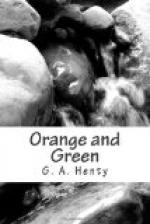The honours of the fight certainly rested with the Irish, who, against a vastly superior force, comprising some of the best troops in Europe, maintained themselves throughout the day, and gained, indeed, in most points, a decided advantage.
King James’s valour had entirely evaporated before the first shot was fired. Instead of following William’s example, and leading his troops in the conflict which was to decide the fate of his crown, and which he himself had precipitated, he took up his position at a safe distance from danger, on the hill of Donore, and as soon as the battle approached that point he rode off to Duleek, where he placed himself at the head of the French troops, and led their retreat. He soon, however, rode on ahead, and arrived in Dublin in a state of consternation and despair, the first fugitive from the field of battle. In the meantime the army was whole and unbroken, marching in perfect order from the field of battle, while its king and commander was doing his best to ruin the cause by spreading dismay and alarm throughout the country.
The next morning the king sent for the mayor and corporation of Dublin, and told them that he was under the necessity of taking care of himself, and recommended them to do the same, and to make the best terms they could with the enemy. He then at once mounted and made his flight to Waterford, ordering the bridges to be broken down behind him, although the British army had not yet moved from its position on the Boyne. On reaching Waterford James at once embarked on board the ship he had ordered to be in readiness, and sailed for France. His conduct, and his conduct alone, converted the battle of the Boyne, which was in effect a kind of drawn battle, into a great victory for William.
It had, indeed, more than answered the object which the Irish commanders proposed to themselves. Their plan was to accustom the new and badly armed levies to stand firm against the steadiness and experience of William’s veteran troops, and then to withdraw without committing themselves to a decisive combat, with a view of protracting the campaign until William should be forced to leave Ireland, and his foreign army should be worn out by winter service in an uncongenial climate. Every day would, they calculated, improve their own army and weaken and reduce that of the enemy.
Their position at the Boyne enabled them to try their plan of partial combat to what extent they chose, without danger of being forced into a more extensive action than they deemed expedient. The Irish troops had greatly surpassed the expectation of their own officers, and had filled William’s generals with amazement; and it is probable that, if a large part of the infantry and artillery had not been sent off early in the day, the experiment might have been turned into a brilliant victory. As it was, William was so surprised and alarmed at the resistance he had encountered, that he remained some days at the Boyne




